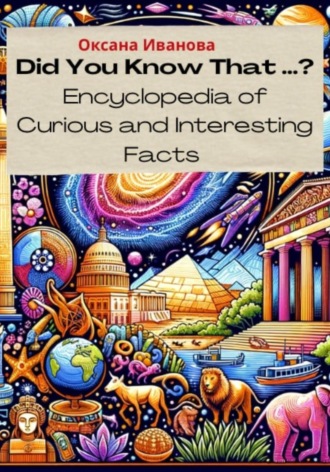
Полная версия
Did You Know That ? Encyclopedia of Curious and Interesting Facts

Оксана Иванова
Did You Know That ? Encyclopedia of Curious and Interesting Facts
Fact 1. Did you know that the Great Wall of China is visible from space?
It's true! The Great Wall of China is one of the most iconic structures on Earth, and it's so large that it can even be seen from space. In fact, it's one of the only man-made structures that is visible from orbit.
The Great Wall was built over a period of centuries, starting in the 7th century BC. It was originally built to protect China from invaders, and it stretches for over 13,000 miles across the country. The wall is made of stone, brick, and earth, and it's up to 30 feet high in some places.
The Great Wall is a UNESCO World Heritage Site, and it's one of the most popular tourist destinations in China. Every year, millions of people visit the wall to see its incredible size and beauty.
The Great Wall of China is a testament to the ingenuity and perseverance of the Chinese people. It's a symbol of China's rich history and culture, and it's one of the most amazing sights on Earth.
Here are some other interesting facts about the Great Wall of China:
● The wall was built by hand, using simple toolsand materials.
● It took over 2,000 years to build the wall.
● The wall was built by millions of workers, including soldiers, prisoners, and peasants.
● The wall was never completely finished.
● The wall has been damaged over the centuries by war, erosion, and natural disasters.
● The wall is now protected as a UNESCO World Heritage Site.
● The wall is one of the most popular tourist destinations in China.
WORDLIST:
invaders – захватчики
stretches for – простирается на
brick – кирпич
Heritage – наследие
tourist destinations – туристические направления
incredible – невероятный
testament – свидетельство
ingenuity – изобретательность
perseverance – настойчивость
tools – инструменты
prisoners – заключенные
peasants – крестьяне
erosion – эрозия
natural disasters – природные бедствия
QUESTIONS:
Is the Great Wall of China visible from space?
When was the Great Wall of China built?
What was the purpose of the Great Wall of China?
How long is the Great Wall of China?
What materials was the Great Wall of China made from?
How tall is the Great Wall of China in some places?
What is the status of the Great Wall of China as a UNESCO World Heritage Site?
Why is the Great Wall of China one of the most popular tourist destinations in China?
How was the Great Wall of China built?
How long did it take to build the Great Wall of China?
Who built the Great Wall of China?
Was the Great Wall of China ever completely finished?
What has damaged the Great Wall of China over the centuries?
Fact 2. Did you know that the first telephone call was made in 1876?
Imagine a world without phones. No smartphones, no landlines, no way to instantly connect with someone who isn't right next to you. It may seem impossible, but that's exactly how it was before the invention of the telephone.
On March 10, 1876, that all changed when Alexander Graham Bell uttered the historic words, "Mr. Watson, come here; I want you." These words marked the first successful transmission of speech over a wire. Bell had invented the telephone, and the world would never be the same again.
The early telephone was a far cry from the sophisticated devices we use today. It consisted of a transmitter and a receiver, connected by a wire. The transmitter converted sound waves into electrical signals, which were then transmitted through the wire to the receiver. The receiver converted the electrical signals back into sound waves, allowing the person on the other end to hear what was being said.
The first telephone call was a monumental achievement, but it was only the beginning. Over the next few years, Bell and other inventors made significant improvements to the telephone, making it more powerful, reliable, and affordable. By the end of the 1800s, telephones were becoming widespread in homes and businesses, revolutionizing the way people communicated.
Today, the telephone is an essential part of our lives. We use it to stay connected with friends and family, conduct business, and access information. It's hard to imagine a world without it.
But as we marvel at the convenience and power of modern communication, it's important to remember where it all began. The first telephone call was a small step, but it was a step that changed the world forever.
Here are some additional facts about the first telephone call:
● The call lasted about two seconds.
● Bell's assistant, Thomas Watson, was the one who answered the call.
● The call was made from Bell's laboratory in Salem, Massachusetts.
● The phone was initially called the "telephone."
● The first telephone switchboard was invented in 1878.
● By 1900, there were over 1 million telephones in use in the United States.
WORDLIST:
landlines – стационарные телефоны
instantly – мгновенно
invention – изобретение
uttered – произнес
transmission of speech – передача речи
wire – провод
a far cry from – далеко от
sophisticated – сложный
consisted of – состоял из
transmitter – передатчик
receiver – приемник
sound waves – звуковые волны
monumental – монументальный
achievement – достижение
significant improvements – значительные улучшения
reliable – надежный
affordable – доступный
widespread – широко распространенный
essential – существенный
conduct business – вести бизнес
access – доступ
marvel – удивляться
convenience – удобство
additional – дополнительный
assistant – помощник
telephone switchboard – телефонная станция
QUESTIONS:
When was the first telephone call made?
Who invented the telephone?
What were the first telephones like?
How did the telephone revolutionize communication?
What are some additional facts about the first telephone call?
How long did the first telephone call last?
Who answered the first telephone call?
Where was the first telephone call made from?
What was the telephone initially called?
When was the first telephone switchboard invented?
How many telephones were in use in the United States by 1900?
Fact 3. Did you know that the Statue of Liberty was a gift from France?
One of the most iconic landmarks in the world, the Statue of Liberty is a symbol of freedom and democracy. But did you know that this beloved statue was actually a gift from France?
The Statue of Liberty was conceived by French sculptor Frédéric Auguste Bartholdi in the late 1800s. He envisioned a colossal statue that would stand at the entrance to New York Harbor, welcoming immigrants from all over the world.
The statue was a joint effort between France and the United States. Bartholdi designed and sculpted the statue, while Gustave Eiffel, the engineer behind the Eiffel Tower, designed the statue's internal structure. The statue was built in France and then disassembled and shipped to the United States in 350 pieces.
On October 28, 1886, the Statue of Liberty was dedicated in a grand ceremony in New York Harbor. President Grover Cleveland presided over the ceremony, and thousands of people gathered to witness the unveiling of the statue.
The Statue of Liberty quickly became a symbol of hope and freedom for immigrants arriving in the United States. It was also a symbol of the strong friendship between France and the United States.
Today, the Statue of Liberty is one of the most popular tourist destinations in the world. Millions of people visit the statue each year to admire its beauty and to learn about its history.
The Statue of Liberty is more than just a statue. It is a symbol of freedom, democracy, and friendship. It is a reminder of the strong ties between France and the United States, and it is a testament to the power of human creativity.
Here are some additional facts about the Statue of Liberty:
● The statue is made of copper.
● The statue is 151 feet tall from the base to the torch.
● The statue weighs 450,000 pounds.
● The statue's torch is made of gold leaf.
● The statue's crown has 25 windows, representing the 25 rays of the sun.
● The statue's pedestal is made of granite.
● The statue is located on Liberty Island in New York Harbor.
● The statue was designated a UNESCO World Heritage Site in 1984.
WORDLIST:
landmarks – достопримечательности
freedom – свобода
beloved – любимый
was conceived – был задуман
envisioned – представлял себе
entrance – вход
harbor – гавань
joint effort – совместные усилия
internal – внутренний
disassembled – разобранный
was dedicated – был посвящен
witness – свидетель
unveiling – открытие
tourist destinations – туристические направления
admire – восхищаться
reminder – напоминание
strong ties – прочные связи
testament – свидетельство
human creativity – человеческое творчество
additional – дополнительный
copper – медь
torch – факел
weighs – весит
gold leaf – сусальное золото
crown – корона
rays – лучи
Heritage – наследие
QUESTIONS:
Who conceived the Statue of Liberty?
Who designed the Statue of Liberty's internal structure?
Where was the Statue of Liberty built?
When was the Statue of Liberty dedicated?
Who presided over the dedication ceremony?
What is the Statue of Liberty made of?
How tall is the Statue of Liberty?
How much does the Statue of Liberty weigh?
What is the Statue of Liberty's torch made of?
How many windows are in the Statue of Liberty's crown?
What does the Statue of Liberty's crown represent?
Where is the Statue of Liberty located?
When was the Statue of Liberty designated a UNESCO World Heritage Site?
Fact 4. Did you know that the ancient Egyptians used to shave their eyebrows as a sign of mourning?
This intriguing practice, along with other elaborate grooming rituals, offers a fascinating glimpse into their complex society and belief system.
The Cultural Context of Mourning
In ancient Egyptian culture, mourning was a time of intense grief and sorrow. To honor the deceased and express their pain, mourners engaged in various rituals, including shaving their eyebrows. This practice was not limited to the immediate family but also extended to friends and even servants.
Symbolic Significance of Eyebrows
In Egyptian art, eyebrows were often depicted as symbols of beauty, youth, and vitality. Their absence, therefore, represented the loss of these qualities and the transition into a state of mourning. By removing their eyebrows, mourners sought to physically manifest their sadness and detachment from the world.
Other Mourning Practices
Eyebrow shaving was just one aspect of a broader mourning repertoire. Other practices included:
● Wearing dark clothing and covering the face with dust or mud
● Refraining from bathing, perfuming, or using cosmetics
● Cutting off fingernails and hair
● Weeping and wailing in public processions
Gendered Mourning Rituals
Mourning practices differed slightly between men and women. While both shaved their eyebrows, men were also known to grow their beards as a sign of grief. Women, on the other hand, typically wore long, disheveled hair.
Duration of Mourning
The duration of mourning varied depending on the social status of the deceased. For high-ranking individuals, such as pharaohs and priests, mourning could last up to 70 days. For ordinary citizens, it typically lasted between 30 and 40 days.
Hygiene and Religious Beliefs
In addition to its symbolic significance, eyebrow shaving was also a practical hygiene measure. During mourning, Egyptians were expected to remain in a state of ritual purity. Shaving eyebrows helped prevent lice and other parasites from infesting the face.
Evolution of Mourning Practices
Over time, Egyptian mourning practices evolved. During the Roman period, eyebrow shaving became less common, while other forms of mourning, such as covering the face with a veil, gained prominence.
Legacy of Egyptian Grooming
The grooming practices of ancient Egyptians continue to fascinate scholars and enthusiasts alike. By understanding the cultural and symbolic significance of these practices, we gain a deeper appreciation for the complexities of their society and their beliefs about life and death.
WORDLIST:
intriguing – интригующий
elaborate – сложный
grooming rituals – ритуалы ухода
glimpse – проблеск
mourning – траур
ancient – древний
intense grief – сильное горе
sorrow – печаль
deceased – умерший
pain – боль
various – различные
shaving their eyebrows – бритье бровей
immediate family – ближайшие родственники
servants – слуги
significance – значение
depicted as – изображались как
youth – молодость
vitality – жизненная сила
absence – отсутствие
therefore – поэтому
detachment – отчуждение
dust – пыль
refraining – воздержание
fingernails – ногти
weeping – плач
wailing – стенание
slightly – немного
beards – бороды
on the other hand – с другой стороны
disheveled hair – растрепанные волосы
duration – продолжительность
priests – жрецы
ordinary citizens – простые граждане
purity – чистота
prevent – предотвращать
lice – вши
from infesting – от заражения
grooming practices – практики ухода
scholars – ученые
appreciation – признательность
QUESTIONS:
What was the significance of shaving eyebrows in ancient Egyptian mourning practices?
How did the duration of mourning vary in ancient Egypt?
What other mourning practices were common in ancient Egypt besides shaving eyebrows?
How did mourning practices differ between men and women in ancient Egypt?
What practical hygiene benefit did eyebrow shaving provide during mourning?
How did Egyptian mourning practices evolve over time?
What is the legacy of ancient Egyptian grooming practices?
What can we learn about ancient Egyptian society and beliefs from their grooming practices?
How did ancient Egyptians depict eyebrows in their art?
What is the cultural context of mourning in ancient Egypt?
Fact 5. Did you know that the average lifespan of a goldfish is about 10 years?
The average lifespan of a goldfish is about 10 years. However, with proper care, some goldfish can live for much longer. The oldest known goldfish, named Tish, lived for an incredible 43 years!
Factors Affecting Lifespan
Several factors can affect a goldfish's lifespan, including:
● Genetics: Some breeds of goldfish, such as the Ryukin and the Oranda, have a shorter average lifespan than others like the Shubunkin and the Comet.
● Water Quality: Poor water conditions can stress goldfish and shorten their lives. Regular tank cleaning, proper filtration, and optimal water chemistry are essential.
●Diet: A balanced and nutritious diet is vital for goldfish health. Avoid overfeeding, as goldfish are prone to obesity.
● Stress: Environmental stressors, such as overcrowding, aggressive tank mates, or frequent handling, can negatively impact goldfish lifespan.
● Temperature: Goldfish prefer cool water temperatures ranging from 60°F to 72°F (16°C to 22°C). Extreme temperatures can shorten their life.
Maximizing Goldfish Lifespan
By understanding the factors that influence a goldfish's lifespan, we can take steps to maximize it:
● Choose Healthy Fish: Start with healthy goldfish that are free from disease
and have a good body shape.
● Provide a Spacious Tank: Avoid overcrowding by choosing a tank that is large enough for all the goldfish.
● Maintain Clean Water: Perform regular water changes and use a suitable
filter to keep the water free of toxins.
● Feed a Balanced Diet: Feed goldfish a variety of foods, including high-quality
pellets, flakes, and frozen or live food.
● Minimize Stress: Provide a peaceful environment with ample hiding places and tank mates that are compatible with goldfish.
● Monitor Temperature: Ensure that the water temperature remains within the optimal range.
● Seek Veterinary Care: If you notice any signs of illness, consult a veterinarian
promptly.
Conclusion
By providing our beloved goldfish with the best possible conditions, we can help them reach the full extent of their potential lifespan and enjoy their companionship for many years to come.
WORDLIST:
average – средний
lifespan – продолжительность жизни
proper care – надлежащий уход
incredible – невероятный
breeds – породы
regular tank cleaning – регулярная чистка аквариума
proper – надлежащий
essential – существенный
nutritious – питательный
vital – жизненно важный
avoid – избегать
overfeeding – перекармливание
are prone to – подвержены
obesity – ожирение
overcrowding – перенаселение
mates – товарищи
frequent – частый
handling – обращение
disease – болезнь
spacious – просторный
suitable – подходящий
pellets – гранулы
flakes – хлопья
compatible – совместимый
promptly – незамедлительно
conclusion – заключение
QUESTIONS:
What is the average lifespan of a goldfish?
What is the oldest known goldfish on record?
Name three factors that can affect a goldfish's lifespan.
How can you minimize stress for goldfish?
What is the optimal water temperature range for goldfish?
What is a sign that you should seek veterinary care for your goldfish?
What are two types of food that you can feed goldfish?
What is one way to avoid overcrowding in a goldfish tank?
What is the importance of maintaining clean water in a goldfish tank?
Fact 6. Did you know that the human body contains about 60% water?
The human body contains about 60% water. That means that for every 100 pounds you weigh, about 60 pounds of it is water! Water is essential for life. It helps our bodies to:
● Regulate temperature
● Transpor nutrients and oxygen to cells
● Remove waste products
● Lubricate joints
● Protect organs and tissues
Why is staying hydrated important?
When we don't drink enough water, we can become dehydrated. Dehydration can lead to a number of health problems, including:
● Fatigue
● Headache
● Constipation
● Muscle cramps
● Dizziness
● Confusion
● Seizures
● Coma
In severe cases, dehydration can be fatal.
How much water should I drink?
The amount of water you need to drink each day depends on a number of factors, including:
● Your activity level
● The climate you live in
● Your overall health
As a general rule of thumb, adults should drink eight glasses of water per day. However, if you are exercising or living in a hot climate, you may need to drink more.
Tips for staying hydrated
Here are a few tips for staying hydrated:
● Drink water throughout the day, even if you don't feel thirsty.
● Carry a water bottle with you and refill it throughout the day.
● Add fruit or vegetables to your water for flavor.
● Eat fruits and vegetables that are high in water content, such as watermelon, strawberries, and cucumbers.
Conclusion
Water is essential for our health and well-being. By staying hydrated, we can help our bodies function properly and avoid a number of health problems. So next time you're thirsty, reach for a glass of water and enjoy the benefits of this life-giving liquid!









